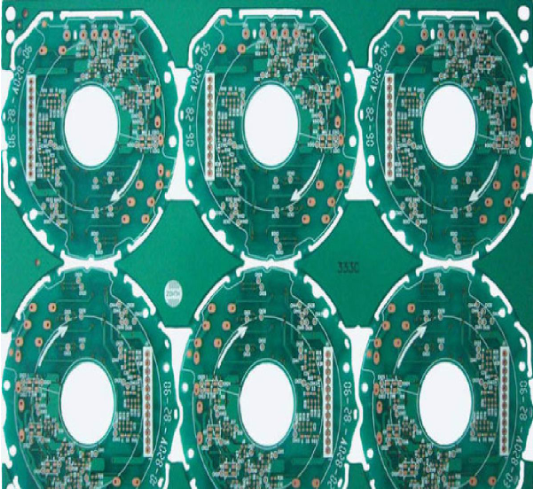Overview of PCB high-frequency board selection and production and processing methods!
One, the definition of PCB high frequency board
High-frequency board refers to a special circuit board with a higher electromagnetic frequency. It is used for high-frequency (frequency greater than 300MHz or wavelength less than 1 meter) and microwave (frequency greater than 3GHZ or wavelength less than 0.1 meter). The copper board is a circuit board produced by using part of the process of the ordinary rigid circuit board manufacturing method or using a special processing method. Generally speaking, a high-frequency board can be defined as a circuit board with a frequency above 1GHz.
With the rapid development of science and technology, more and more equipment designs are applied in the microwave frequency band (>1GHz) and even in the millimeter wave field (30GHz). This also means that the frequency is getting higher and higher, and the base of the circuit board The requirements for materials are getting higher and higher. For example, the substrate material needs to have excellent electrical properties, good chemical stability, and the loss on the substrate with the increase of the power signal frequency is very small, so the importance of the high-frequency board is highlighted.

2. PCB high frequency board application field
Mobile communication products, intelligent lighting systems; power amplifiers, low-noise amplifiers, etc.; passive components such as power splitters, couplers, duplexers, filters, etc.; automotive anti-collision systems, satellite systems, radio systems and other fields, high electronic equipment Frequency is the development trend.
Third, the classification of high-frequency boards
1. The processing method of powder ceramic filled thermosetting material: similar to epoxy resin/glass woven cloth (FR4), except that the sheet is relatively brittle and easy to break. The life of the drill and gong knife will be reduced by 20 when drilling and gongs. %.
2, PTFE (polytetrafluoroethylene) material processing method:
Material: The protective film must be retained to prevent scratches and creasing;
Drilling: Use a brand new drill tip (standard 130), one by one is the best, the pressure of the presser foot is 40psi; the aluminum sheet is the cover plate, and then use a 1mm melamine backing plate to tighten the PTFE plate; after drilling, use an air gun The dust in the hole is blown out; use the most stable drilling machine and drilling parameters (basically, the smaller the hole, the faster the drilling speed, the smaller the Chip load, the lower the return speed).
hole treatment: plasma treatment or sodium naphthalene activation treatment is conducive to hole metallization.
PTH copper sinking: After micro-etching (with 20 micro-inch control of the micro-etching rate), the plate is loaded from the de-oiling cylinder when the PTH is pulled; if necessary, the second PTH is passed, and the plate is only loaded from the expected cylinder.
Solder mask: pre-treatment: use acid washing, can not use mechanical grinding; after pre-treatment, baking board (90 degree Celsius, 30min), brush green oil to cure; baking board in three stages: one section 80 degree Celsius, 100 degree Celsius, 150 degree Celsius, The time is 30min each (If you find that the substrate surface is oily, you can rework: wash off the green oil and reactivate it).
Gong board: Lay white paper on the circuit surface of the PTFE board, and clamp the upper and lower sides with the FR-4 substrate board or phenolic base plate with a thickness of 1.0MM etched to remove the copper. The base material and the copper surface are separated by a sulphur-free paper of a considerable size and inspected visually. To reduce burrs, the key point is that the gong board process must have a good effect.
Four, process flow
1. NPTH's PTFE plate processing flow: cutting-drilling-dry film-inspection-etching-corrosion inspection-solder mask-character-spray tin-molding-testing-final inspection-packaging-shipment.
2. PTH's PTFE plate processing flow: cutting-drilling-hole treatment (plasma treatment or sodium naphthalene activation treatment)-copper immersion-board electricity-dry film-inspection-diagram electricity-etching-corrosion inspection-solder mask-character -Spray tin-forming-testing-final inspection-packing-shipping.
Difficulties in high-frequency board processing: copper sinking: the hole wall is not easy to be copper; map transfer, etching, line width line gap, sand hole control; green oil process: green oil adhesion, green oil blistering control; each process appears Strictly control scratches on the board surface, etc.
In the field of high-frequency board manufacturing business, the PCB factory must always maintain an efficient multi-variety rapid delivery capability, aiming to build China's strongest PCB prototype and small and medium-sized batch manufacturing plant, combining high-quality lean production management, R&D and manufacturing capabilities, and the company's continuous The leading advantages such as the core technology of PCB construction have helped Chinese enterprises with independent intellectual property rights to continuously accelerate technological innovation and development.